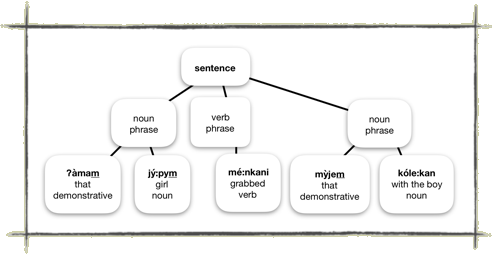distinctions between these two "thats"
will be described in Lesson 6
In Dr. Ultan's dissertation on Konkow, he talks about a "compounding suffix." The Mountain Maidu grammar book, by Karen Anderson who we are grateful to for sharing this concept, talks about it this way:
In [a previous lesson], we talked about the –m
subject marker on nouns. There is another type of –m that is used to
tie all describing and specifying words together in a phrase. Instead of just saying “coyote,”
you might want to say “that coyote,” or “that big, bad coyote.” Or instead of just saying
“a woman,” you might want to say “those three other hungry women.” Think of the noun as the star
of the phrase. “Coyote” is the star of the phrase “The big bad coyote”. All the other words are
just saying what kind of coyote it is.
In Maidu, all the describing words leading up to the noun (the star of the phrase) have to be
linked together with -m suffixes, even if the noun is not the subject
of the sentence.

NOTE: if either the describing word or the “star” noun ends in a consonant, add -im instead of -m. The -m on the describing words acts the same way as the subject marker.
Another note: kóle:kan means “with (the) boy”.
So if you use the verb root mé: which has been translated as “grab”, the object of grab has to have that suffix -kan. (Remember that in the exercises.)
In the sentence above, the object noun phrase comes after the verb. Remember that in Chapter 2, we showed objects before the verb. So you see that it is fine to do it either way.
Some describing words can be made into verbs, too. For example, ʔetiti “green” with the verb final suffix -n on it becomes ʔetitin “(It) is green.”
This is directly from the story of the Lost Swimmer. Ultan always puts the describing words together with the noun as a single word. We think it is easier to read if we write them separately. But as you study the texts, you will see them as Ultan wrote them; so this exercise is to help you learn how to pick the words apart.
A big (i.e. important) man told me, “(I) will let (you) go.”
See if you can rewrite that noun phrase with the words separated, and put dashes between the roots and suffixes. You can label the parts of each word if you want to. In the text analyses we are calling the suffix a " relational," because it serves to relate the descriptive words to the star noun.
wỳktemhèlpemmájdymà
Here are some describing words that you can use to make noun phrases. We are also adding the corrected words for “girl” and “girls.” Combine these with the vocabulary from Lesson 1 to do this exercise.
The green turtle ate the big cane.
That young boy grabbed the big, bluish rock.
The two young girls looked at the green river.
Word order is variable. These answers each have one of the possible orders, but others are okay too.
These are the concepts you should be familiar with from Lesson 5
- 1. Describing words describe something about the “star” noun of a noun phrase.
- 2. All the describing words before the star noun take an -m/-im suffix, which we call a “relational” because it relates the describing words to the nouns. Ultan calls this suffix the “compounding” suffix.
- 3. Like other suffixes we have discussed, if the root ends in a consonant, this suffix is -im after a consonant and -m after a vowel.
- 4. Ultan puts the describing words together with the noun without spaces between. For purposes of these lessons, we like to separate them for ease of reading.
Want to learn more? All the Mary Jones videos lessons are available HERE
